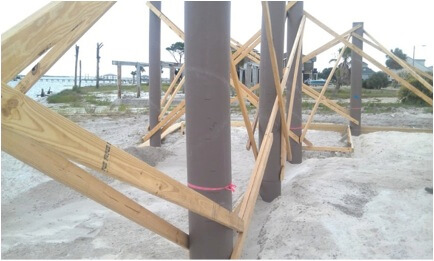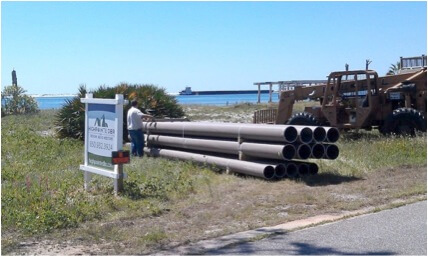One of the key ideas to sustainable or Green Construction is the use of long-lasting and environmentally-friendly components, like fiberglass pilings.
Simply put, a house that lasts 50 years and costs the same as one that lasts 60 is more expensive over the long run. To avoid excessive cost over the life of a building, pre-construction planning and evaluation allow owners and builders to compare costs across various construction options.
New products and technology are key to increasing the lifespan and efficiency of new construction. By considering the various expenses of ownership including utilities, maintenance, insurance, lifespan and even the likelihood of hurricane-related damages, an owner can make an informed decision and maximize his or her investment. And, while I make it sound more complicated than it is, a house that costs more to build that also costs less to own and operate over the long run can be the less expensive and Greener alternative.
Evaluating Anchored Piling Foundation Alternatives
Building Components and construction techniques can vary wildly in costs. In elevated construction which is so prevalent along the coast of Northwest Florida, one of the most important considerations in design is the cost and function of the foundation. With frequent hurricanes and exposure to rising water and high winds, an anchored piling foundation is required in much of our area — and is a wise investment in many places where it’s not.
As such, for years designers and builders have found themselves balancing the costs and benefits of concrete vs. timber piles. While concrete piles cost more than timber, they’re widely accepted as stronger and longer lasting. In some cases, fewer concrete pilings can be used to support a house, so there’s careful consideration that goes into the decision and alternatives must be evaluated.
At Highpointe, we tend to enjoy using new technology and believe that stronger is always better. So, when we were recently asked to consider the use of hollow, fiberglass composite pilings we were skeptical, but very interested.
Hollow Fiberglass Composite Pilings
We had to ask: “How can hollow fiberglass composite pilings be strong enough?” Well, it turns out that not only are they strong enough, but they’re stronger than timber piles and pre-stressed concrete pilings!
At the request of our clients, we contacted the Pearson Piling Company in Fall River, Massachusetts. Having seen the Pearson Pilings www.pearsonpilings.com used on a project near their home, our client presented us with the opportunity to consider and later to design and build their new beach house using Pearson’s pilings.
At first, it seemed unlikely to us that the system could possibly be strong enough. However, we also knew that cautious instincts are no match for scientific data and facts. So, we did the research, consulted with our engineer, and discovered that not only were the Pearson Pilings stronger than timber, but they’re stronger than concrete.
Individually, Pearson Pilings are more expensive than timber, but their increased strength means fewer are needed and they’re lighter than concrete so they’re easier to work with. Unlike concrete pilings that contain rebar, there is no risk of deterioration of the pilings or eventual pile spalling.
Less Expensive in the Long Run
So, when we did the math, we found the overall cost of fiberglass pilings to be significantly less over the long run compared to timber or concrete pilings. And, since the fiberglass pilings “won’t rust, rot or crumble,” they’ll last virtually forever. Of course, because they’re better looking, perfectly round, and won’t ever splinter, they’re a great material that we’ll be looking forward to using again in the future – maybe on your house!
Long life at lower cost and higher strength is something to strive for and, well, that’s what Green Building is all about.



